![]()
Pattern Making- The Late Bustle Era Bodice
![]() Measuring
Measuring ![]()
All right get out your textbook with your measuring chart Bust measurement
(also found here), your pencil, your tape measure, your square, and your friend or partner and prepare to
measure.
What are the keys to a good set of measurements?
You will find some helpful hints on page 3 of your textbook but the main points are-
![]() First off- wear the same undergarments you intend to wear with your outfit. Many seamstresses
have in the past bewailed the fact customers changing their foundation garments from fitting to fitting.
First off- wear the same undergarments you intend to wear with your outfit. Many seamstresses
have in the past bewailed the fact customers changing their foundation garments from fitting to fitting.
I highly recommend you wear a corset and chemise under an 1880's dress. Your bustle and petticoats should also
be worn. Do not fret if you do not have a wire bustle. A bustle is easily made and if you are portraying an average
lady out west- your bustle would have likely been a very small crescent shaped pillow, made to fill out the back
of your dress a bit. Get dressed in your underwear and solicit the help of a good friend to help you take the measurements- as they are nearly impossible to take for one's
self. If you are not used to wearing a corset, you might think about one of Past Patterns sensible stays patterns
to help smooth the lines. They are really a bit early for the late bustle period but are better than the lines
of modern undergarments.
![]() Measure SNUGGLY NOT TIGHTLY! You should be able to insert you finger between the tape and
your body easily. Neither should you measure with alot of "wearing ease" A late bustle era bodice should
fit very closely!
Measure SNUGGLY NOT TIGHTLY! You should be able to insert you finger between the tape and
your body easily. Neither should you measure with alot of "wearing ease" A late bustle era bodice should
fit very closely!
![]() Next locate
your waist and sides- a bit of narrow masking tape can be handy to make sure all measurements are from the same
points when taking side to side measurements and waist to whatever measurements. Place the masking tape at your
true waistline (it may be higher or lower at back or front) and from underarm center to waist on both sides of
your body. The line for the side tape will be in line from the center of your underarm to your hip (stand up straight
and let your arm fall directly to your side and this should show you about where this line should fall.) Your waistline
will be defined if you are wearing a corset- if not then use the crease formed when bending from side to side as
a reference. This gives you handy reference points for standard measuring and adds no noticeable bulk.
Next locate
your waist and sides- a bit of narrow masking tape can be handy to make sure all measurements are from the same
points when taking side to side measurements and waist to whatever measurements. Place the masking tape at your
true waistline (it may be higher or lower at back or front) and from underarm center to waist on both sides of
your body. The line for the side tape will be in line from the center of your underarm to your hip (stand up straight
and let your arm fall directly to your side and this should show you about where this line should fall.) Your waistline
will be defined if you are wearing a corset- if not then use the crease formed when bending from side to side as
a reference. This gives you handy reference points for standard measuring and adds no noticeable bulk.
In my photos I have substituted a narrow ribbon to mark the waist and sideseams. I also have the over petticoat
at hip level rather than adding bulk right at the waistline. (The base petticoat is worn under the corset and over
the chemise. Then the bustle, then the overpetticoat)
Make sure you measure to the same edge of the masking tape marked waistline each time you take a measurement. (I
suggest measuring to the bottom edge or the bodice may be too short.)
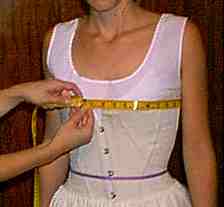
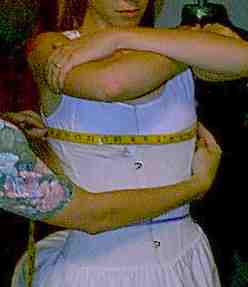
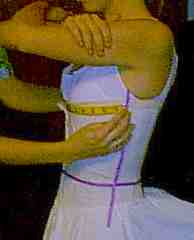
measuring bust arc
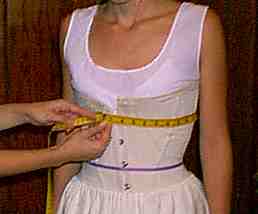
Underbust
just under the bustline
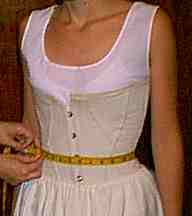
waist measurement
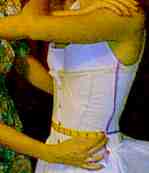
waist arc
measured from side seam to side seam

waist arc
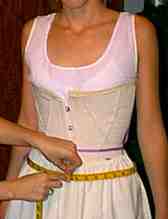
High Hip
measured 3" down from waistline.
Abdomen measurment is taken in the front from side to side at high hip level.
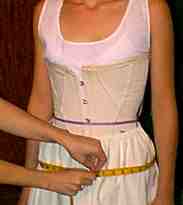
Hip
Take this measurement at the fullest point of the hip over the petticoats without the extra bustle.
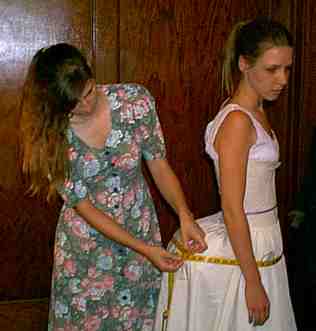
Hip over bustle
Again at the fullest hip point -you will want this measurement especially if you wear a large bustle
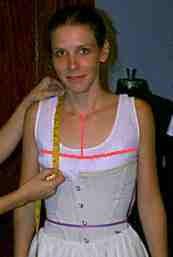
Shoulder to Bustpoint
measure to fullest point of bust or just below. This will indicate how high your bust darts will be.
Chest depth is measured from the center front of neck to the chest level (as shown by red line)
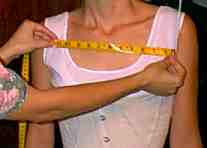
Armhole to Armhole
The square may once again be of use as a reference point- this measure will tell you how deep your armscye will
need to be drawn into the front bodice- measure it carefully and err on the side of too long rather than too short-
you can always trim extra from your muslin if need be later.
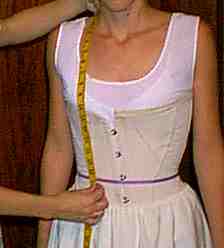
Shoulder to Waistline
make sure you go straight down over the fullest bust point to the waistline.
Especially important for fuller bustlines as you will need extra length in the front to prevent your bodice from
being short waisted. Measure to the bottom of your waistline marker.
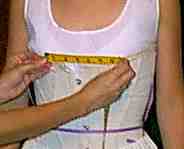
Bustpoint to Bustpoint
where your bust peaks on each breast- determines how far apart the bust darts will be.
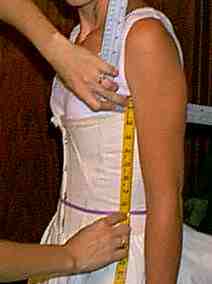
Armscye to waistline
you do not want this measurement to start at the armpit, but where the armscye should lie instead. Use your square
to help give you a point of reference- tuck it under the arm with the arm down and measure from the top of the
square to the waistline.
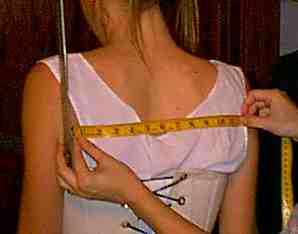
Back width- to help get this measurement accurately stick the square under the arm and measure straight out from
the square to the center of the backbone and multiply times two- or use two squares one under each arm for a point
of reference. Remember to hold the tape straight and do not "curve it" around the body.
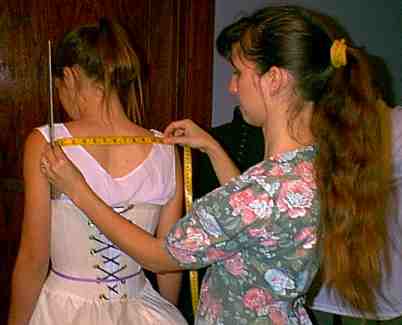
Shoulder width-
again use you square to help give you a point of reference.

Shoulder length- this is a tricky measurement and one most often mis-measured. Take it from the base of the neck
to where the arm joins the body. On this illustration it would be about to the outer edge of the chemise to the
base of the neck.
(note: this is the appropriate length for the 1880's-90's, in the late 1870's it will be a bit longer almost to
the edge of the shoulder line)
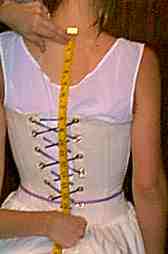
Back Waist length
This is measured from the base of the neck to the bottom of the waistline marker. (If yo measure to the top edge
your bodice will be too short waisted and "crawl up")
Lesson 1-Page 2
Lesson Index
Page 1- 2 - 3 - 4 - 5 - 6
- 7 - 8 - 9
Copyright 2001 by Marna Jean Davis. All contents of the websites
associated with the lessons of Marna Jean Davis and Shooting Star Enterprises are protected by U.S. copyright laws.
They may be printed out by registered students for their own personal use but may not be reprinted in any other
manner or reproduced in any form.
Costume Classroom is a division of The Costume Gallery, copyright 1997-2001.
Having problems with this webpage contact: questions@costumeclassroom.com